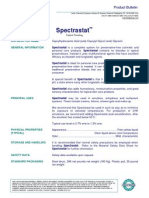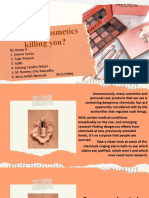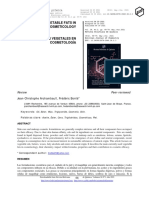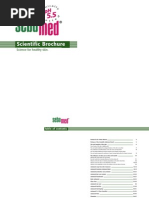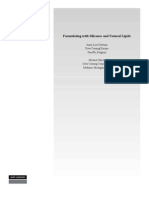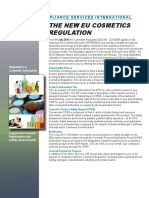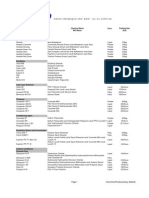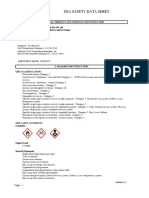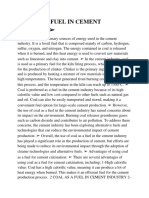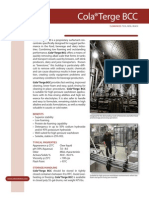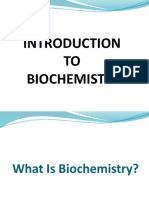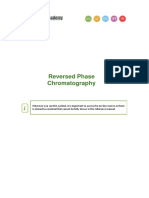Cosmetics Toxicity
Cosmetics Toxicity
Uploaded by
RekhaCopyright:
Available Formats
Cosmetics Toxicity
Cosmetics Toxicity
Uploaded by
RekhaOriginal Description:
Copyright
Available Formats
Share this document
Did you find this document useful?
Is this content inappropriate?
Copyright:
Available Formats
Cosmetics Toxicity
Cosmetics Toxicity
Uploaded by
RekhaCopyright:
Available Formats
Toxic Chemicals in Cosmetics - Ingredient Directory
Do this simple exercise on a few of the personal care products you and your loved ones use on an everyday
basis. It could be your toothpaste, shampoo or a moisturizing cream or deodorant. See how many of the toxic
ingredients listed in the table below you can find in your cosmetics and personal care products.
Here is a typical list on a jar of common hand cream: Water, - Stearic Acid, - Sorbitol, - Glycerin, - C-12-15
Alkyl Benzoate, - Sodium Borate - TEA, - Cetyl Alcohol, - Dimethicone, - Aloe Vera, - Phenoxyethanol, -
Propylene Glycol, - Quince Extract, - Tocopheryl Acetate, - Potassium Sorbate, - EDTA, - Allantoin, - Methyl
Paraben, - Propyl Paraben, - Butyl Paraben, - Menthol
The product is described as containing "natural" herbal extracts. YOU do your own exercise and see how
many toxic chemicals you can find in your products that are listed below. Remember this is just a partial list
of the tens of thousands of chemicals in common use - some 85,000 of them now at last count!
1,4-dioxane 2-bromo-2-nitropropane-1,3-diol (Bronopol) Alcohol, Isopropyl (SD-40)
Ammonium Laureth Sulfate (ALES) Ammonium Lauryl Sulfate (ALS) Anionic Surfactants
Benzalkonium Chloride Butylated Hydroxyanisole (BHA) Butylated Hydroxytoluene (BHT)
Cationic surfactants Cetalkonium chloride Chloromethylisothiazolinone & Isothiazolinone
Cocoamidopropyl Betaine Cocoyl Sarcosine Cyclomethicone
DEA (diethanolamine) Diazolidinyl urea Dimethicone
Disodium Dioctyl Sulfosuccinate DMDM Hydantoin Ethoxylated surfactants
FD&C Colour Pigments Formaldehyde Fragrance
Hydrolysed Animal Protein Imidazolidinyl Urea Isopropyl Palmitate
Lanolin Lauryl dimonium hydrolysed collagen Lauryl or Cocoyl Sarcosine
Lauryl Sarcosine Liquidum Paraffinum MEA compounds
Methylisothiazolinone Methylchloroisothiazolinone Mineral Oil
Nitrosating Agents
Paraben preservatives (methyl, propyl, butyl, and
ethyl)
Paraffin wax/oil
Polyethylene Glycol (PEG) compounds Propylene/Butylene Glycol PVP/VA Copolymer
Quaternium-7, 15, 31, 60, etc Rancid Natural Emollients Sodium Cocoyl Sarcosinate
Silicone derived emollients Sodium Hydroxide Sodium Laureth Sulfate
SLES Sodium Methyl Cocoyl Taurate Stearalkonium Chloride
Talc TEA (Triethanolamine) Laureth Sulfate Toluene
For more information visit www.health-report.co.uk
For facts on specific toxic chemicals
www.hazard.com/msds
Toxic Chemicals - Ingredient Directory
1,4-dioxane Back to Top
Antioxidant
Patented Stem Cell Nutrition
A carcinogenic contaminant of cosmetic products. Almost 50% of cosmetics
containing ethoxylated surfactants were found to contain dioxane. See
Ethoxylated surfactants
From Material Safety Data Sheet (MSDS):
1,4-DIOXANE MAY EXERT ITS EFFECTS THROUGH INHALATION, SKIN
ABSORPTION, AND INGESTION.
1,4-DIOXANE IS LISTED AS A CARCINOGEN.
EFFECTS OF OVEREXPOSURE: 1,4-DIOXANE IS AN EYE AND MUCOUS
MEMBRANE IRRITANT, PRIMARY SKIN IRRITANT, CENTRAL NERVOUS SYSTEM
DEPRESSANT, NEPHROTOXIN, AND HEPATOTOXIN.
ACUTE EXPOSURE CAUSES IRRITATION, HEADACHE, DIZZINESS, AND
NARCOSIS. CHRONIC INHALATION EXPOSURE CAN PRODUCE DAMAGE TO THE
LIVER AND KIDNEYS, AND BLOOD DISORDERS.
MEDICAL CONDITION AGGRAVATED BY EXPOSURE PRECLUDE FROM EXPOSURE
THOSE INDIVIDUALS WITH DISEASE OF THE BLOOD, LIVER KIDNEYS,
CENTRAL NERVOUS SYSTEM, AND THOSE SUSCEPTIBLE TO DERMATITIS.
2-bromo-2-nitropropane-1,3-diol
(Bronopol)
Toxic, causes allergic contact dermatitis.
See Nitrosating agents
Alcohol, Isopropyl (SD-40) Back to
Top
A very drying and irritating solvent and dehydrator that strips your skin's
natural acid mantle, making us more vulnerable to bacteria, moulds and
viruses. It is made from propylene, a petroleum derivative. It may promote
brown spots and premature aging of skin.
Ammonium Laureth Sulfate (ALES) See Anionic Surfactants
See Sodium Laureth Sulfate
See Nitrosating Agents
Ammonium Lauryl Sulfate (ALS)
Back to Top
See Anionic Surfactants
See Sodium Laureth Sulfate
See Nitrosating Agents
Anionic Surfactants
Back to Top
Antioxidant
Anionic refers to the negative charge these surfactants have. They may be
contaminated with nitrosamines, which are carcinogenic. Surfactants can pose
serious health threats. They are used in car washes, as garage floor cleaners
and engine degreasers - and in 90% of personal-care products that foam.
Sodium Lauryl Sulfate (SLS)
Sodium Laureth Sulfate (SLES)
Ammonium Lauryl Sulfate (ALS)
Patented Stem Cell Nutrition
Ammonium Laureth Sulfate (ALES)
Sodium Methyl Cocoyl Taurate
Sodium Lauroyl Sarcosinate
Sodium Cocoyl Sarcosinate
Potassium Coco Hydrolysed Collagen
TEA (Triethanolamine) Lauryl Sulfate
TEA (Triethanolamine) Laureth Sulfate
Lauryl or Cocoyl Sarcosine
Disodium Oleamide Sulfosuccinate
Disodium Laureth Sulfosuccinate
Disodium Dioctyl Sulfosuccinate etc
Benzalkonium Chloride
Back to Top
Antioxidant
Patented Stem Cell Nutrition
Highly toxic, primary skin irritant.
See Cationic surfactants
From Material Safety Data Sheet (MSDS):
MATERIAL IS HIGHLY TOXIC VIA ORAL ROUTE.
EFFECTS OF OVEREXPOSURE: MISTS CAN CAUSE IRRITATION TO THE SKIN,
EYES, NOSE, THROAT AND MUCOUS MEMBRANES. AVOID DIRECT CONTACT.
SYMPTOMS: MUSCULAR PARALYSIS, LOW BLOOD PRESSURE, CNS
DEPRESSION AND WEAKNESS.
EMERGENCY AND FIRST AID PROCEDURES
EYES: CORROSIVE! IMMEDIATELY WASH EYES WITH PLENTY OF WATER.
INHALATION: REMOVE PERSON TO FRESH AIR. GIVE OXYGEN (IF BREATHING
IS DIFFICULT). CALL PHYSICIAN.
INGESTION: IF CONSCIOUS, IMMEDIATELY DRINK LARGE QUANTITIES OF
FLUID TO DILUTE AND INDUCE VOMITING. CALL PHYSICIAN.
Butylated Hydroxyanisole (BHA) Dr Epstein reports in his book Unreasonable Risk this chemical is carcinogenic!
Also known to cause allergic contact dermatitis.
Butylated Hydroxytoluene (BHT) Causes allergic contact dermatitis. Contains toluene.
See Toluene
Cationic surfactants
Back to Top
Antioxidant
These chemicals have a positive electrical charge. They contain a quaternary
ammonium group and are often called "quats". These are used in hair
conditioners, but originated from the paper and fabric industries as softeners
and anti-static agents. In the long run they cause the hair to become dry and
brittle. They are synthetic, irritating, allergenic and toxic, and oral intake of
them can be lethal.
Stearalkonium chloride
Benzalkonium chloride
Cetrimonium chloride
Cetalkonium chloride
Lauryl dimonium hydrolysed collagen
Cetalkonium chloride See Cationic surfactants
Cetrimonium chloride See Cationic surfactants
Chloromethylisothiazolinone and Causes contact dermatitis
Isothiazolinone
Back to Top
Antioxidant
Patented Stem Cell Nutrition
Causes contact dermatitis
From Material Safety Data Sheet (MSDS):
EYE CONTACT: CORROSIVE TO THE EYES WITH POSSIBLE PERMANENT
DAMAGE.
SKIN CONTACT: CORROSIVE TO THE SKIN, POSSIBLY RESULTING IN THIRD
DEGREE BURNS. CAN BE HARMFUL IF ABSORBED. CAN CAUSE ALLERGIC
CONTACT DERMATITIS IN SUSCEPTIBLE INDIVIDUALS.
INGESTION: CAN BE FATAL.
INHALATION: CAN BE CORROSIVE TO THE MUCOUS MEMBRANES AND THE
LUNGS. CAN CAUSE AN ALLERGIC REACTION IN SUSCEPTIBLE INDIVIDUALS.
Cocoamidopropyl Betaine From Material Safety Data Sheet (MSDS):
CAN CAUSE EYE AND SKIN IRRITATION.
Cocoyl Sarcosine See Nitrosating agents
Cyclomethicone See Silicone derived emollients
DEA (diethanolamine), MEA
(Monoethanolamine), & TEA
(triethanolamine)
Back to Top
Antioxidant
Patented Stem Cell Nutrition
Often used in cosmetics to adjust the pH, and used with many fatty acids to
convert acid to salt (stearate), which then becomes the base for a cleanser.
TEA causes allergic reactions including eye problems, dryness of hair and skin,
and could be toxic if absorbed into the body over a long period of time.
These chemicals are already restricted in Europe due to known carcinogenic
effects. Dr. Samuel Epstein (Professor of Environmental Health at the University
of Illinois) says that repeated skin applications . . . of DEA-based detergents
resulted in a major increase in the incidence of liver and kidney cancer.
See Nitrosating agents
From Material Safety Data Sheet (MSDS):
Health Hazard Acute And Chronic: Product is severely irritating to body tissues
and possibly corrosive to the eyes.
Explanation Carcinogenicity: Amines react with nitrosating agents to form
nitrosamines, which are carcinogenic.
Diazolidinyl urea
Back to Top
Antioxidant
Patented Stem Cell Nutrition
Established as a primary cause of contact dermatitis (American Academy of
Dermatology). Contains formaldehyde, a carcinogenic chemical, is toxic by
inhalation, a strong irritant, and causes contact dermatitis.
See Formaldehyde
From Material Safety Data Sheet (MSDS):
CAUSES SEVERE EYE IRRITATION. MAY CAUSE SKIN IRRITATION. SIGNS AND
SYMPTOMS OF EXPOSURE
SYMPTOMS OF INHALATION: IF MISTED, WILL CAUSE IRRITATION OF MUCOUS
MEMBRANES, NOSE, EYES AND THROAT. COUGHING, DIFFICULTY IN
BREATHING.
SYMPTOMS OF SKIN CONTACT: CONTACT CAUSES SMARTING AND BURNING
SENSATIONS, INFLAMMATION, BURNS, PAINFUL BLISTERS. PROFOUND
DAMAGE TO TISSUE.
SYMPTOMS OF EYE CONTACT: WILL CAUSE PAINFUL BURNING OR STINGING
OF EYES AND LIDS, WATERING OF EYES, AND INFLAMMATION OF
CONJUNCTIVA.
Dimethicone Back to Top See Silicone derived emollients
Dimethicone Copolyol See Silicone derived emollients
Disodium Dioctyl Sulfosuccinate See Anionic surfactants
Disodium Laureth Sulfosuccinate See Anionic surfactants
See Ethoxylated surfactants
Disodium Oleamide Sulfosuccinate See Anionic Surfactants
DMDM Hydantoin Contains formaldehyde.
See Formaldehyde
Ethoxylated surfactants
Back to Top
Antioxidant
Ethoxylated surfactants are widely used in cosmetics as foaming agents,
emulsifiers and humectants. As part of the manufacturing process the toxic
chemical 1,4-dioxane, a potent carcinogen, is generated.
On the label, they are identified by the prefix "PEG", "polyethylene",
"polyethylene glycol", "polyoxyethylene", "-eth-", or "-oxynol-".
See 1,4-Dioxane
FD&C Colour Pigments
Back to Top
Synthetic colours made from coal tar. Contain heavy metal salts that deposit
toxins onto the skin, causing skin sensitivity and irritation. Animal studies have
shown almost all of them to be carcinogenic.
Formaldehyde Formaldehyde is a known carcinogen (causes cancer). Causes allergic, irritant
and contact dermatitis, headaches and chronic fatigue. The vapour is extremely
Back to Top
irritating to the eyes, nose and throat (mucous membranes).
See Nitrosating agents
Fragrance
Back to Top
Antioxidant
Fragrance on a label can indicate the presence of up to four thousand separate
ingredients, many toxic or carcinogenic. Symptoms reported to the USA FDA
include headaches, dizziness, allergic rashes, skin discoloration, violent
coughing and vomiting, and skin irritation. Clinical observation proves
fragrances can affect the central nervous system, causing depression,
hyperactivity, and irritability.
Hydrolysed Animal Protein See Nitrosating agents
Imidazolidinyl urea
Back to Top
The trade name for this chemical is Germall 115. Releases formaldehyde, a
carcinogenic chemical, into cosmetics at over 10C. Toxic. See Formaldehyde
Imidazolidinyl Urea See Nitrosating agents
Isopropyl Palmitate A fatty acid from palm oil combined with synthetic alcohol. Industry tests on
rabbits indicate the chemical can cause skin irritation and dermatitis. Also
shown to be comedogenic (acne promoting)
Lanolin
Back to Top
Any chemicals used on sheep will contaminate the lanolin obtained from the
wool. The majority of lanolin used in cosmetics is highly contaminated with
organo-phosphate pesticides and insecticides.
Lauryl dimonium hydrolysed
collagen
See Cationic surfactants
Lauryl or Cocoyl Sarcosine See Anionic Surfactants
Lauryl Sarcosine See Nitrosating agents
Liquidum Paraffinum Liquidum Paraffinum is an exotic sounding way to say mineral oil (!!) See
Mineral Oil
MEA compounds See Nitrosating agents
Methylisothiazolinone and
Methylchloroisothiazolinone
Both cause cosmetic allergies
Mineral Oil
Back to Top
Antioxidant
Petroleum by-product that coats the skin like plastic, clogging the pores.
Interferes with skin's ability to eliminate toxins, promoting acne and other
disorders. Slows down skin function and cell development, resulting in
premature aging. Used in many products (baby oil is 100% mineral oil!) Any
mineral oil derivative can be contaminated with cancer causing PAH's
(Polycyclic Aromatic Hydrocarbons). Manufacturers use petrolatum because it is
unbelievably cheap.
Breast cancer and impurities. EWG's assessment of product ingredient labels
and data on cancer-causing chemicals identified three common impurities in
personal care products that are linked to mammary tumors in animal studies
Patented Stem Cell Nutrition
ethylene oxide, PAHs, and 1,3-butadiene. Since September 2004 the EU has
banned the use of petroleum jelly due to the carcinogenic contamination found
in products containing petrolatum. The ingredients for which these impurities
are of concern are used in one of every four personal care products on the
market. Read More
Mineral oil
Liquidum paraffinum (also known as posh mineral oil!)
Paraffin oil
Paraffin wax
Petrolatum
Nitrosating Agents
Back to Top
Antioxidant
Patented Stem Cell Nutrition
The following chemicals can cause nitrosamine contamination, which have been
determined to form cancer in laboratory animals. There are wide and repeated
concerns in the USA and Europe about the contamination of cosmetics products
with nitrosamines.
2-bromo-2-nitropropane-1,3-diol
Cocoyl Sarcosine
DEA compounds
Imidazolidinyl Urea
Formaldehyde
Hydrolysed Animal Protein
Lauryl Sarcosine
MEA compounds
Quaternium-7, 15, 31, 60, etc
Sodium Lauryl Sulfate
Ammonium Lauryl Sulfate
Sodium Laureth Sulfate
Ammonium Laureth Sulfate
Sodium Methyl Cocoyl Taurate
TEA compounds
Paraben preservatives (methyl,
propyl, butyl, and ethyl)
Back to Top
Antioxidant
Used as inhibitors of microbial growth and to extend shelf life of products.
Widely used even though they are known to be toxic. Have caused many
allergic reactions and skin rashes. Highly toxic.
From Material Safety Data Sheet (MSDS):
EMERGENCY OVERVIEW:
WARNING! HARMFUL IF SWALLOWED OR INHALED. CAUSES IRRITATION TO
SKIN, EYES AND RESPIRATORY TRACT. MAY CAUSE ALLERGIC SKIN REACTION.
SKIN CONTACT: CAUSES IRRITATION TO SKIN. SYMPTOMS INCLUDE
REDNESS, ITCHING, AND PAIN. MAY CAUSE ALLERGIC SKIN REACTIONS.
EYE CONTACT: CAUSES IRRITATION, REDNESS, AND PAIN.
Paraffin wax/oil Paraffin Wax is mineral oil wax. See Mineral Oil
Phthalates
Antioxidant
Toxic gender bending chemical used as a plasticizer in food wraps and many
pliable plastics and containers. Also used in hairsprays and some cosmetics
including nail varnishes from where it is readily absorbed into the system. All
289 people in a recent test for body load of chemicals tested positive for
phthalates. Phthalates are implicated with low sperm counts and also causing
sexual abnormalities and deformities. An in depth article on phthalates can be
found on the www.health-report.co.uk website
Polyethylene Glycol (PEG)
compounds
Back to Top
Potentially carcinogenic petroleum ingredient that can alter and reduce the
skin's natural moisture factor. This could increase the appearance of aging and
leave you more vulnerable to bacteria. Used in cleansers to dissolve oil and
grease. It adjusts the melting point and thickens products. Also used in caustic
spray-on oven cleaners. See Ethoxylated surfactants
Potassium Coco Hydrolysed
Collagen
See Anionic Surfactants
Propylene/Butylene Glycol
Back to Top
Antioxidant
Patented Stem Cell Nutrition
Propylene glycol (PG) is a petroleum derivative. It penetrates the skin and can
weaken protein and cellular structure. Commonly used to make extracts from
herbs. PG is strong enough to remove barnacles from boats! The EPA considers
PG so toxic that it requires workers to wear protective gloves, clothing and
goggles and to dispose of any PG solutions by burying them in the ground.
Because PG penetrates the skin so quickly, the EPA warns against skin contact
to prevent consequences such as brain, liver, and kidney abnormalities. But
there isn't even a warning label on products such as stick deodorants, where
the concentration is greater than in most industrial applications.
From Material Safety Data Sheet (MSDS):
Health Hazard Acute And Chronic
INHALATION: May cause respiratory and throat Irritation, central nervous
system depression, blood and kidney disorders. May cause Nystagmus,
Lymphocytosis.
SKIN: Irritation and dermatitis, absorption.
EYES: Irritation and conjunctivitis.
INGESTION: Pulmonary oedema, brain damage, hypoglycaemia, intravascular
hemolysis. Death may occur.
PVP/VA Copolymer
Back to Top
A petroleum-derived chemical used in hairsprays, wavesets and other
cosmetics. It can be considered toxic, since particles may contribute to foreign
bodies in the lungs of sensitive persons.
Quaternium-7, 15, 31, 60, etc Toxic, causes skin rashes and allergic reactions. Formaldehyde releasers. Dr
Epstein reports in his book Unreasonable Risk "Substantive evidence of casual
relation to leukaemia, multiple myeloma, non-Hodgkin's lymphoma and other
Back to Top
Antioxidant
cancers"
See Nitrosating agents
From Material Safety Data Sheet (MSDS):
SKIN: PROLONGED OR REPEATED EXPOSURE MAY CAUSE SKIN IRRITATION.
MAY CAUSE MORE SEVERE RESPONSE IF SKIN IS DAMP.
MAY BE A WEAK SKIN SENSITIZER IN SUSCEPTIBLE INDIVIDUALS AT GREATER
THAN 1% IN AQUEOUS SOLUTION.
Rancid Natural Emollients
Back to Top
Antioxidant
Natural oils used in cosmetics should be cold pressed. The refined vegetable oils
found on supermarket shelves and many health food stores which lack colour,
odour and taste are devoid of nutrients, essential fatty acids, vitamins and
unsaponifiables - all valuable skin conditioning agents! They also contain
poisonous "trans" fatty acids as a result of the refining process.
Another important factor to consider with creams made from plant oil is the
use-by date. The most beneficial plant oils (like rosehip, borage and evening
primrose oils) are polyunsaturated, which means they oxidise and go rancid
fairly quickly (about 6 months). Most off-the-shelf cosmetics have a shelf life of
three years. Rancid oils are harmful, they form free-radicals, which damage and
age your skin.
Silicone derived emollients
Back to Top
Antioxidant
Patented Stem Cell Nutrition
Silicone emollients are occlusive - that is they coat the skin, trapping anything
beneath it, and do not allow the skin to breathe (much like plastic wrap would
do.)
Recent studies have indicated that prolonged exposure of the skin to sweat, by
occlusion, causes skin irritation. Some synthetic emollients are known tumour
promoters and accumulate in the liver and lymph nodes. They are also non-
biodegradable, causing negative environmental impact.
Dimethicone
Dimethicone Copolyol
Cyclomethicone
Silicone was and still is used as breast implants. Tens of thousands of women
with breast implants have complained of debilitating symptoms. Anecdotal
evidence indicates silicone to be toxic to the human body. For more detailed
information on the dangers of silicone simply key "silicone toxicity" into the
Google search engine
Sodium Cocoyl Sarcosinate See Anionic Surfactants
Sodium Hydroxide Also known as caustic soda. A powerful alkali used in industry for cleaning
drains and pipe lines also used in oven cleaners. Workers exposed to steam
containing sodium hydroxide have suffered lung damage and an increased risk
of throat cancer. Used in toothpastes and as a pH adjuster in skin creams.
Antioxidant
Patented Stem Cell Nutrition
Causes contact dermatitis and sensitizes individuals to other chemicals.
From Material Safety Data Sheet (MSDS): POISON! DANGER! CORROSIVE.
MAY BE FATAL IF SWALLOWED. HARMFUL IF INHALED. CAUSES BURNS TO ANY
AREA OF CONTACT. REACTS WITH WATER, ACIDS AND OTHER MATERIALS
Ingestion:
Corrosive! Swallowing may cause severe burns of mouth, throat, and stomach.
Severe scarring of tissue and death may result. Symptoms may include
bleeding, vomiting, diarrhea, fall in blood pressure. Damage may appears days
after exposure.
Skin Contact:
Corrosive! Contact with skin can cause irritation or severe burns and scarring
with greater exposures.
Eye Contact:
Corrosive! Causes irritation of eyes, and with greater exposures it can cause
burns that may result in permanent impairment of vision, even blindness.
Chronic Exposure:
Prolonged contact with dilute solutions has a destructive effect upon tissue.
Aggravation of Pre-existing Conditions:
Persons with pre-existing skin disorders or eye problems or impaired
respiratory function may be more susceptible to the effects of the substance.
Sodium Laureth Sulfate (SLES)
Ammonium Laureth Sulfate (ALES)
Back to Top
Antioxidant
When combined with other chemicals, SLES and ALES can create nitrosamines,
a potent class of carcinogens. It is frequently disguised in semi-natural
cosmetics with the explanation "comes from coconut".
See Anionic Surfactants
See Ethoxylated surfactants
See Nitrosating agents
From Material Safety Data Sheet (MSDS):
WARNING! CAUSES SKIN AND EYE IRRITATION! AVOID CONTACT WITH EYES,
SKIN AND CLOTHING. THE MATERIAL WAS CLASSIFIED AS A MODERATE TO
SEVERE EYE IRRITANT.
Sodium Lauroyl Sarcosinate See Anionic Surfactants
Sodium Lauryl Sulfate (SLS)
Ammonium Lauryl Sulfate (ALS)
Back to Top
Antioxidant
Used in car washes, garage floor cleaners and engine degreasers - and in 90%
of products that foam.
Animals exposed to SLS and ALS experience eye damage, central nervous
system depression, laboured breathing, diarrhoea, severe skin irritation, and
even death.
Young eyes may not develop properly if exposed to SLS and ALS because
proteins are dissolved. SLS and ALS may also damage the skin's immune
system by causing layers to separate and inflame. It is frequently disguised in
semi-natural cosmetics with the explanation "comes from coconut".
Patented Stem Cell Nutrition
See Nitrosating agents
See Anionic Surfactants
From Material Safety Data Sheet (MSDS):
EYE CONTACT:
INSTILLATION OF A 29% SODIUM LAURYL SULFATE SOLUTION INTO THE EYES
OF SIX ALBINO RABBITS PRODUCED SEVERE IRRITATION. THE MATERIAL WAS
CLASSIFIED AS A SEVERE SKIN IRRITANT.
Sodium Methyl Cocoyl Taurate See Nitrosating agents
See Anionic Surfactants
Stearalkonium Chloride
Back to Top
A chemical used in hair conditioners and creams. Causes allergic reactions.
Stearalkonium chloride was developed by the fabric industry as a fabric
softener, and is a lot cheaper and easier to use in hair conditioning formulas
than proteins or herbals, which do help hair health. Toxic.
See Cationic surfactants
Talc
Back to Top
Scientific studies have shown that routine application of talcum powder in the
genital area is associated with a three-to-fourfold increase in the development
of ovarian cancer.
TEA (Triethanolamine) Laureth
Sulfate
Back to Top
Antioxidant
Patented Stem Cell Nutrition
Synthetic emulsifier. Highly acidic. Over 40% of cosmetics containing
Triethanolamine (TEA), have been found to be contaminated with nitrosamines,
which are potent carcinogens.
From Material Safety Data Sheet
Special Hazard Precautions: PRODUCT IS SEVERELY IRRITATING TO BODY
TISSUES AND POSSIBLY CORROSIVE TO THE EYES. HANDLE WITH CARE.
AVOID EYE & SKIN CONTACT. AVOID BREATHING VAPORS IF GENERATED. IF
THERE IS DANGER OF EYE CONTACT, WEAR A FACE SHIELD.
Explanation Carcinogenicity: AMINES REACT WITH NITROSATING AGENTS TO
FORM NITROSOAMINES, WHICH ARE CARCINOGENIC.
See Anionic Surfactants
See Nitrosating agents
TEA compounds See Nitrosating agents
Toluene
Back to Top
From Material Safety Data Sheet (MSDS):
POISON! DANGER! HARMFUL OR FATAL IF SWALLOWED. HARMFUL IF INHALED
OR ABSORBED THROUGH SKIN.
VAPOR HARMFUL. FLAMMABLE LIQUID AND VAPOR. MAY AFFECT LIVER,
KIDNEYS, BLOOD SYSTEM, OR CENTRAL NERVOUS SYSTEM. CAUSES
Patented Stem Cell Nutrition
Antioxidant
IRRITATION TO SKIN, EYES AND RESPIRATORY TRACT.
INHALATION: INHALATION MAY CAUSE IRRITATION OF THE UPPER
RESPIRATORY TRACT. SYMPTOMS OF OVEREXPOSURE MAY INCLUDE FATIGUE,
CONFUSION, HEADACHE, DIZZINESS AND DROWSINESS. PECULIAR SKIN
SENSATIONS (E. G. PINS AND NEEDLES) OR NUMBNESS MAY BE PRODUCED.
VERY HIGH CONCENTRATIONS MAY CAUSE UNCONSCIOUSNESS AND DEATH.
INGESTION: SWALLOWING MAY CAUSE ABDOMINAL SPASMS AND OTHER
SYMPTOMS THAT PARALLEL OVER-EXPOSURE FROM INHALATION. ASPIRATION
OF MATERIAL INTO THE LUNGS CAN CAUSE CHEMICAL PNEUMONITIS, WHICH
MAY BE FATAL. SKIN CONTACT: CAUSES IRRITATION. MAY BE ABSORBED
THROUGH SKIN.
EYE CONTACT: CAUSES SEVERE EYE IRRITATION WITH REDNESS AND PAIN.
CHRONIC EXPOSURE: REPORTS OF CHRONIC POISONING DESCRIBE ANEMIA,
DECREASED BLOOD CELL COUNT AND BONE MARROW HYPOPLASIA. LIVER
AND KIDNEY DAMAGE MAY OCCUR. REPEATED OR PROLONGED CONTACT HAS
A DEFATTING ACTION, CAUSING DRYING, REDNESS, AND DERMATITIS.
EXPOSURE TO TOLUENE MAY AFFECT THE DEVELOPING FOETUS.
You might also like
- Wastewater Treatment Technologies Design Consideration by MritunjayDocument259 pagesWastewater Treatment Technologies Design Consideration by MritunjayThetti TunNo ratings yet
- MakeupcatalogDocument32 pagesMakeupcatalogivanaNo ratings yet
- Where To Find Free Cosmetic Formulas 10.08.2012Document14 pagesWhere To Find Free Cosmetic Formulas 10.08.2012Pakistan-cosmetics Manufacturers100% (2)
- A New Generation of Preservatives For Cosmetic FormulationsDocument5 pagesA New Generation of Preservatives For Cosmetic FormulationsKingson_786100% (1)
- Spectra StatDocument1 pageSpectra StatAtul MehtaNo ratings yet
- LipsticksDocument6 pagesLipsticksMarcelo Partes de Oliveira100% (1)
- HLBsDocument3 pagesHLBsrafaeldelperuNo ratings yet
- Handbook of Formulating Dermal Applications: A Definitive Practical GuideFrom EverandHandbook of Formulating Dermal Applications: A Definitive Practical GuideNo ratings yet
- Cosmetic Industry Dirty SecretsDocument21 pagesCosmetic Industry Dirty Secretssedeq1No ratings yet
- Dangerous Beauty The Chemical Evils in Personal Care Product - Group 9Document44 pagesDangerous Beauty The Chemical Evils in Personal Care Product - Group 9nova indah nurmalaNo ratings yet
- Vegetable Fats in CosmeticologyDocument12 pagesVegetable Fats in CosmeticologyBolivian Journal of ChemistryNo ratings yet
- 10 Toxic Beauty Ingredients To AvoidDocument3 pages10 Toxic Beauty Ingredients To AvoidAnna SkylerNo ratings yet
- Personal Care SurfactantsDocument72 pagesPersonal Care Surfactantseduardoaffre100% (1)
- Sodium Lauryl SulfateDocument9 pagesSodium Lauryl SulfateMoxzJr VianzNo ratings yet
- Beauty & Personal Care Ingredients ListDocument11 pagesBeauty & Personal Care Ingredients ListtmlNo ratings yet
- GumsDocument18 pagesGumsJefferson ThiamNo ratings yet
- Scientific Brochure: Science For Healthy SkinDocument25 pagesScientific Brochure: Science For Healthy SkinHunt ApplegateNo ratings yet
- Modern Skin Cleansers PDFDocument15 pagesModern Skin Cleansers PDFLianella Gil LaureiroNo ratings yet
- Taking Care of Your Formulations - 2003Document43 pagesTaking Care of Your Formulations - 2003microbiologist125100% (4)
- Skin Whitening Products ReportDocument23 pagesSkin Whitening Products ReportSophia Marie Dapar100% (1)
- Castor OilDocument19 pagesCastor OilPraks SaxenaNo ratings yet
- Anti-Dandruff Shampoo With Zinc Pyrithione: INCI Name, Trade Name Weight % FunctionDocument2 pagesAnti-Dandruff Shampoo With Zinc Pyrithione: INCI Name, Trade Name Weight % FunctionandreeaNo ratings yet
- Lightenex-Max-Peel FinalDocument24 pagesLightenex-Max-Peel FinalhoplittaNo ratings yet
- Hyrdosheer Suncare PresentationDocument26 pagesHyrdosheer Suncare PresentationicraoNo ratings yet
- Formulation of Nail Lacquers - Cosmetic FormulationDocument10 pagesFormulation of Nail Lacquers - Cosmetic FormulationPankaj Patel100% (1)
- Course OutlineDocument3 pagesCourse OutlineUmar ZamirNo ratings yet
- Herbal Cosmetics Handbook - Chapter 'COSMETIC EMULSIONS'Document54 pagesHerbal Cosmetics Handbook - Chapter 'COSMETIC EMULSIONS'randatagNo ratings yet
- BB Cream Hoy PDFDocument2 pagesBB Cream Hoy PDFunnik06No ratings yet
- 8.color Cosmetics-IDocument24 pages8.color Cosmetics-Ikamasuke hegdeNo ratings yet
- Silicone Oils and Natural OilsDocument6 pagesSilicone Oils and Natural Oilsאורית פלטיNo ratings yet
- Formulation WtitteningDocument28 pagesFormulation WtitteningAnonymous P5Oyoa1q7100% (1)
- Formulations of Cosmetics and Personal Care:: Before Starting..Document14 pagesFormulations of Cosmetics and Personal Care:: Before Starting..Erik SnchzNo ratings yet
- The New Sunscreens Among Formulation StrategyDocument11 pagesThe New Sunscreens Among Formulation StrategydewiNo ratings yet
- Formulating Tips For Shampoo-Body WashDocument2 pagesFormulating Tips For Shampoo-Body WashJohnyNo ratings yet
- Foundation Course Lesson 2 WorksheetDocument4 pagesFoundation Course Lesson 2 WorksheetRaisa KhanNo ratings yet
- EU Cosmetics RegulationDocument2 pagesEU Cosmetics RegulationMonica_Gabriel_4798No ratings yet
- 4 Intro To Cosmetic Emulsions and EmulsificationDocument71 pages4 Intro To Cosmetic Emulsions and EmulsificationAttila MalinikNo ratings yet
- Review Article About The Development and Trends in Preservative Legislation and Safe Alternatives For The Future Verstatil DermosoftDocument5 pagesReview Article About The Development and Trends in Preservative Legislation and Safe Alternatives For The Future Verstatil DermosoftKebunLasti KurniaNo ratings yet
- Antica SpaDocument1 pageAntica Spa120984No ratings yet
- 01 How To Use Preservatives in CosmeticsDocument1 page01 How To Use Preservatives in CosmeticsBlackbeatle63100% (1)
- Diploma in Cosmetic Science: Introduction and Guide To TheDocument12 pagesDiploma in Cosmetic Science: Introduction and Guide To TheKari DbsNo ratings yet
- Shea Butter e BookDocument8 pagesShea Butter e BookColin0% (1)
- Cosmetic Preparations Cosmetic PreparationsDocument24 pagesCosmetic Preparations Cosmetic PreparationsKevin Garala0% (1)
- Herbal Cosmeceutical (MKT 1043) - DR RosnaniDocument95 pagesHerbal Cosmeceutical (MKT 1043) - DR Rosnaniprhasan79No ratings yet
- Medicinal Chemistry and Drug Design: Edited by Deniz EkinciDocument418 pagesMedicinal Chemistry and Drug Design: Edited by Deniz EkinciBalaji Prasanna KumarNo ratings yet
- Formulations HaircareDocument28 pagesFormulations HaircareLiz Tu100% (4)
- Potential and Composition Cosmetic IngredientDocument6 pagesPotential and Composition Cosmetic IngredientHafiz JusohNo ratings yet
- How To Prevent Contamination in Cosmetic ProductsDocument25 pagesHow To Prevent Contamination in Cosmetic ProductsSham SajaNo ratings yet
- COSMETICS8 ThsemDocument92 pagesCOSMETICS8 Thsemalay_brahmbhattNo ratings yet
- Body Care Ingredients To AvoidDocument4 pagesBody Care Ingredients To AvoidadriagNo ratings yet
- Top Skin Whitening Ingredients (Part 2)Document4 pagesTop Skin Whitening Ingredients (Part 2)Prabhakar KumarNo ratings yet
- Antiperspirants and DeodorantsDocument7 pagesAntiperspirants and DeodorantsPriscilla Alioto100% (1)
- CosmeticsDocument3 pagesCosmeticsLuz Gutierrez MontielNo ratings yet
- Recipe Kojic AcidDocument1 pageRecipe Kojic AcidCarolina TarifNo ratings yet
- Eyebrow Soothing Gel FORMULATION #015-136 Ingredient Method Snap ShotDocument1 pageEyebrow Soothing Gel FORMULATION #015-136 Ingredient Method Snap ShotWahyudi WahyudiNo ratings yet
- Self Preservative CosmeticDocument13 pagesSelf Preservative CosmeticimrecoNo ratings yet
- . "Unlocking the Secrets of Beauty: A Guide to Cosmetics" "The Science Behind the Glamour: An Insight into the World of Cosmetics"From Everand. "Unlocking the Secrets of Beauty: A Guide to Cosmetics" "The Science Behind the Glamour: An Insight into the World of Cosmetics"No ratings yet
- Did You Know That There Are Cancer Causing Elements inDocument17 pagesDid You Know That There Are Cancer Causing Elements inRahul SrivastavaNo ratings yet
- Usa Safety Data Sheet: LORD Corporation 111 LORD Drive Cary, NC 27511-7923 USADocument8 pagesUsa Safety Data Sheet: LORD Corporation 111 LORD Drive Cary, NC 27511-7923 USAJean Carlos MottaNo ratings yet
- Harmful Carcinogenic Ingredients in Skin CareDocument3 pagesHarmful Carcinogenic Ingredients in Skin CareDisha T100% (1)
- Toxic Ingredients in Cosmetics Skin Care and Personal Care ProductsDocument15 pagesToxic Ingredients in Cosmetics Skin Care and Personal Care ProductsDavid Kim100% (6)
- Lecture 4 ElectrochemistryDocument50 pagesLecture 4 ElectrochemistryRekhaNo ratings yet
- Flux MethodDocument3 pagesFlux MethodRekhaNo ratings yet
- Ion Selective ElectrodeDocument9 pagesIon Selective ElectrodeRekhaNo ratings yet
- Feng Shui - SkinDocument1 pageFeng Shui - SkinRekhaNo ratings yet
- (Wang Et Al., 2023) - Emulsion and Its Application in The Food Field An Update ReviewDocument18 pages(Wang Et Al., 2023) - Emulsion and Its Application in The Food Field An Update ReviewHerda CahyaningrumNo ratings yet
- Corey E.G., Chelg X. The Logic of Chemical Synthesis (Wiley, SDocument462 pagesCorey E.G., Chelg X. The Logic of Chemical Synthesis (Wiley, SHarrison VanKoten100% (1)
- Proofex GPXDocument2 pagesProofex GPXVenkata RaoNo ratings yet
- Hollow FiberDocument8 pagesHollow FiberAjinkya DesaiNo ratings yet
- MWP11A - Learning Unit 8 PlasticsDocument17 pagesMWP11A - Learning Unit 8 PlasticsThapelo MokoenaNo ratings yet
- Von Neumann and Fuchs Patent An Unlikely Collaboration. Bernstein 2010Document15 pagesVon Neumann and Fuchs Patent An Unlikely Collaboration. Bernstein 2010jleydencoNo ratings yet
- Liquid Crystal Polimer DataDocument9 pagesLiquid Crystal Polimer DataadityaperdanaputraNo ratings yet
- 02 - Technical Specifications - Cast-In-Place ConcreteDocument15 pages02 - Technical Specifications - Cast-In-Place ConcreteMarcons Jon Maturan CasabaNo ratings yet
- G8 Worksheet 3 Particulate Nature of MatterDocument3 pagesG8 Worksheet 3 Particulate Nature of MatterSamantha Jasmine LimNo ratings yet
- ATV NORM LIST Content - Edition - Ma Y20 2008Document6 pagesATV NORM LIST Content - Edition - Ma Y20 2008hamzadakmanNo ratings yet
- Safety Data Sheet: 1 - Product IdentificationDocument4 pagesSafety Data Sheet: 1 - Product IdentificationEnrique FrancoNo ratings yet
- Interference and Diffraction: Physics 112NDocument30 pagesInterference and Diffraction: Physics 112NPrashant BhajantriNo ratings yet
- Float GlassDocument9 pagesFloat GlassA. KARUNYA BHARGAVINo ratings yet
- Metals 08 00932Document15 pagesMetals 08 00932MONER MANUSNo ratings yet
- Potentiometric TitrationDocument12 pagesPotentiometric TitrationTien Haminh100% (1)
- Coal As A Fuel in Cement IndustryDocument3 pagesCoal As A Fuel in Cement IndustryMohamed GamalNo ratings yet
- Apha Q & A: Insight On ColorDocument4 pagesApha Q & A: Insight On ColorSurjeetNo ratings yet
- ColaTerge BCCDocument2 pagesColaTerge BCCmndmattNo ratings yet
- Package 3 - Post Test Rev1Document5 pagesPackage 3 - Post Test Rev1MatthewNo ratings yet
- Module 2 - Che 408Document20 pagesModule 2 - Che 408John Emmanuel Abel Ramos100% (1)
- DGSP - 04 Cumplimiento de Estándares - Lista de Normas y Códigos AplicablesDocument49 pagesDGSP - 04 Cumplimiento de Estándares - Lista de Normas y Códigos AplicablesMarilyn ArreazaNo ratings yet
- Worksheet 1Document2 pagesWorksheet 1Ali SeidNo ratings yet
- Oil PropertiesDocument30 pagesOil PropertiesZain-Alabdeen Haithem LaftaNo ratings yet
- Introduction To BiochemistryDocument97 pagesIntroduction To BiochemistryTsiamo AristideNo ratings yet
- NUMS 2020 Past Paper PakLearningSpot - 1Document13 pagesNUMS 2020 Past Paper PakLearningSpot - 1adnanshahid0039No ratings yet
- Theory of HPLC Reverse Phase ChromatographyDocument93 pagesTheory of HPLC Reverse Phase ChromatographyBenjaminHrustićNo ratings yet
- Abstract - Decanter Cakes Are The Major Wastes: Solid Fuel From Decanter Cake: A Preliminary StudyDocument4 pagesAbstract - Decanter Cakes Are The Major Wastes: Solid Fuel From Decanter Cake: A Preliminary StudyamriNo ratings yet
- Cic7ed ch1 Answers PDFDocument4 pagesCic7ed ch1 Answers PDFWaqar AhmadNo ratings yet
- Vacuum, Steam Ejectors, Atmospheric Air Ejectors PDFDocument13 pagesVacuum, Steam Ejectors, Atmospheric Air Ejectors PDFRichard ObinnaNo ratings yet




